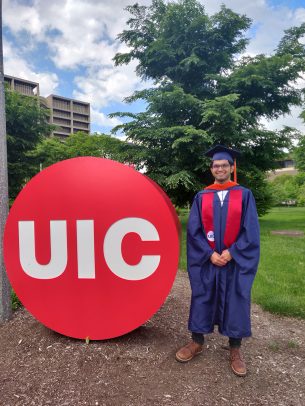Computer science instructor credits course success to online learning

When Chris Kanich transformed his class into an online learning course when the COVID-19 pandemic hit, he did not feel like he was starting from square one.
As an associate professor in computer science within the College of Engineering, Kanich and his colleagues already were well-versed in the use of asynchronous tools such as online discussion boards.
“What I think we had as a department culture, was finding ways to use this technology before the pandemic hit, to best engage our students both synchronously and asynchronously,” Kanich said. “Nearly 90% of courses in computer science were using these asynchronous tools like online discussion boards to support students.”
He pointed to Piazza, an online platform that was a staple in the department, as an example of what they had used even before COVID-19 quarantine. It fostered increased collaboration among students and instructors. He called the format of many of the department’s classes a “flipped classroom, active learning, peer instructional approach.”
These classes moved from in-person to virtual. Kanich would assign videos and readings, and then have questions waiting for students to trigger small group discussions. He would then lecture for several minutes and continue with small-class discussions followed by a lecture and then further discussion in smaller and then full classes.
The structure had allowed itself to be replicated online in Blackboard Collaborate, where small groups could branch off into different “rooms” with Kanich and his teaching assistants monitoring discussions. The constant shift between lectures and discussions helped keep students engaged.
“Having that opportunity to be in the same virtual place at the same time with other people motivated to learn the same content is priceless,” he said. “In my mind, that is the most important part of the value proposition of a UIC degree.”
He said that he kept seeking input and suggestions from his students as the semester continued online and he could adjust to better serve his students. He realized there was a silver lining.
“You had these interesting modalities where some students were not comfortable asking questions out loud in front of a hundred people, but they were totally willing to type in a question in the text box and send that to the faculty member or the class,” Kanich said.

Kanich began preparing for the virtual change in early March when news accounts indicated that the pandemic was spreading. He began helping students become comfortable with Blackboard Collaborate while they were still in a classroom.
This summer he has been building up synchronous course lessons and upgrading production of videos to remotely teach about 200 students in his two fall semester classes. Even if classes are to go back into physical classrooms, he knows the number of students allowed will be limited.
He said that another silver lining is that it has caused him and other instructors to rethink how they are teaching students.
“It’s an opportunity to make big changes that may run against the inertia of traditional teaching,” Kanich said. “When you have a different perspective on what you’re supposed to be doing, you have this opportunity to rethink what works and what doesn’t, and nothing is sacred.”
Anoop Nagabhushana, a graduate student in Kanich’s class, who was finishing his final semester last spring, said he was impressed with Kanich’s transition plan because it was well thought out and flexible. With the Blackboard chat option, he and other students were able to instantly ask questions during the lectures which he would instantly answer or wait at the end to answer. Most of the time the questions led to deeper discussions.
“From my (student) perspective, we didn’t feel we were out of place one bit,” Nagabhushana said. “In fact, I felt empowered as the video lectures involved direct tutoring compared to a lecture directed to a class in a physical setting.”
He also said Kanich’s virtual office hours were extremely helpful and that students learned a lot of new resources.
“I must say, Kanich introduced us to so many tools, we felt the class was better online,” he said.
